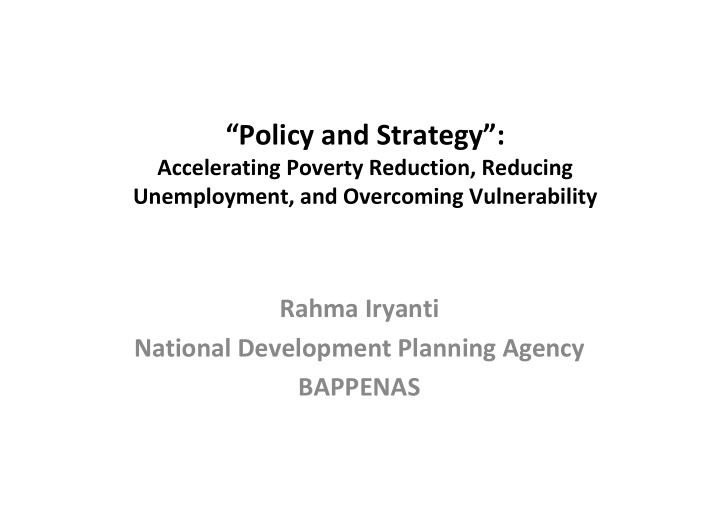



“Policy and Strategy”: Accelerating Poverty Reduction, Reducing Unemployment, and Overcoming Vulnerability Rahma Iryanti National Development Planning Agency BAPPENAS
ISSUES OF EMPLOYMENT • High rate of youth unemployment; • Quality of workers does not meet the requirement of demands; • Income disparities among workers are still wide; • Rise of income is not followed by higher productivity; • Higher ratio of underemployment to open unemployment. 2
Medium Term Development Plan (RPJMN) 2010 ‐ 2014 ECONOMIC DEVELOPMENT AGENDA AND IMPROVING THE PEOPLE’S WELFARE Annual Plan 2010 � National Economic Recovery and Sustaining People’s Welfare Annual Plan 2011 � Accelerating Economic Growth with Equity Supported by Good Governance and Central ‐ Local Synergy INDICATORS Realization 2005 Realization 2006 Realization 2007 Realization 2008 Realization 2009 Realiz Economic growth : 5,7% 5,5 % 6,3% 6,1% 4,5% 5,8% Unemployment: 11,24% 10,28% 9,11% 8,39% 7,87% 7,14% (Augt) Poverty rate: 15,97% 17,75 % 16,58% 15,42% 14,15% 13,33% Projection 2010 Projection 2011 Projection 2012 Projection 2013 Projection 2014 Economic growth: 5.5% ‐ 5.6% 6.0% ‐ 6.3% 6.4% ‐ 6.9% 6.7% ‐ 7.4% 7.0% ‐ 7.7% Unemployment 7.6% 7.3% ‐ 7.4% 6.7% ‐ 7.0% 6.0% ‐ 6.6% 5% ‐ 6% Poverty rate 12.0% ‐ 13.5% 11.5% ‐ 12.5% 10.5% ‐ 11.5% 9.5% ‐ 10.5% 8% ‐ 10% Notes: The RPJM only indicates the end of period target (i.e. target 2014).
Poverty and Unemployment in Rural and Urban Areas Unemployment Areas Poverty (2010) (2010) 19.93 millions Rural 42.0 % (64.2%) 11.10 millions Urban 58,0% (35.8%) 31.02 millions TOTAL 8,3 millions (7.14%) (13.3%) 1. Not all unemployed are poor – DISCOURAGED WORKER 2. Those who work but poor: underemployed (<35 hour) and unpaid worker Challenges: 1.Formal vs informal workers 2.Social protection for the poor 3.Labor protection, and 4.Due to urbanization: urban unemployment and urban poverty 4
Internal/Domestic Challenges 1. Positive economic growth but with increasing the vulnerability of the economy and poor population (need to improve the quality of growth) 2. Absorption of employment opportunities and poverty reduction has slowed down; 3. Urban poverty and urban unemployment due to urbanization. 4. Stagnant and declining economic productivity; 5. Institutional and governance � synergy in policies, multi ‐ sector approaches, regulatory frameworks, and investment climate; 6. Limited infrastructures and environment deterioration; 5
Internal Challenges (continued) 7. Formal worker (32%) and informal worker (68%): Needs higher economic growth (labor intensive industries) to – absorb informal workers (to become formal workers), more decent jobs, better employment climate (industrial relations, protection for workers). 8. Spatial situation: Although poverty rate in Java is lower than the national average, – the highest concentration of poor population is still in Java. How then decentralization (regional autonomy) may respond to – these four (4) problems: poverty, unemployment, and vulnerability 6
Critical Problems 1. Continuous and high economic growth is needed to achieve significant poverty reduction. 2. High growth occurs in sectors with low labor absorption (manufacturing, trade, and services such as finance), while sectors with the highest labor absorption (informal and agriculture) experience lower growth. 3. Economic growth driven by consumption is not matched by the growth in domestic production capacity, which can absorb more labor. 4. Poor population are concentrated in agriculture sector, which experiences relatively stagnant growth. 5. Rural economy is still being dominated by on farm activities, while the expansion of off farm businesses (trade, postharvest processing and handling, agro ‐ industry), which have the potential to increase rural employment and income, are still limited. 6. Program effectiveness declines due to the influence of: a. Decentralization � uncertainty in the relationship between national and local institutions. b. Decentralization � requires governance and improved capacity for creating an enabling environment for businesses, including for micro, small and medium enterprises (MSMEs). 7
“Existing” “Existing” Kondisi di INDONESIA Kondisi di INDONESIA Minat investasi untuk sektor jasa tumbuh lebih cepat dibandingkan dengan sektor manufaktur. Karena daya saing industri padat tenaga kerja � turun akibat kenaikan tingkat upah relatif dibandingkan dengan negara lain.
POLICY DIRECTIONS 1. Creating employment by means of investment and business expansions; 2. Improving condition and mechanism of industrial relation to promote wider business opportunities and employment; 3. Implementing core labor standards and enforcing labor rule of law; 4. Improving quality and competency of workers; 5. Creating employment by means of employment ‐ generating government infrastructure projects; 6. Empowering informal workers; 7. Promoting labor support program by means of labor market information; 8. Adopting migration and development policy. 10
Strategy to Improve the People’s Welfare Welfare Im provem ent Social Protection Social Protection Social Protection Social Protection (Socia l Insura nce) (Socia l Insura nce) Socia l Insura nce) ) ( Socia l Insura nce Inclusive ( Econom ic Developm ent and Growth with Equity Em ploym ent Poverty SMEs Creation Reduction Em powerm ent 1. Improving the labor 1. Institutional development 1. Improving the business quality and competence . for social insurance environment for SMEs 2. Improving the 2. Social assistance 2. Product and market employment climate and 3. Other supports for poverty development for SMEs strengthening the reduction programs 3. Strengthening the industrial relations competitiveness of the 3. Improving the facility human resources of and the protection to cooperatives and SMEs support the mobility of 4. Strengthening the labor. institutions of cooperatives Source: Bappenas 11
Job Strategy Increasing the Policies/ labor capacity Program s to � Education Increase � Training Com petence and � Certification Productivity of � Optimizing Training Workers centers Policies/ Increasing the Social insurance Program s to em ploym ent Policy: Im prove the creation and � Protection for Labor strangthening Environm ent the worker � Pension system com petitiveness Policies/ Program s to Policies and Increase Program s in real Em ploym ent sector: Opportunities � Infrastructure (Em ploym ent � Trade Creation) � Investment � Agriculture � Industry, etc. Regulatory Framework, Budget intervention, Public ‐ Private Cooperation 12 Source: Bappenas
Recommend
More recommend